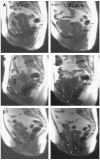The relationship between anterior and apical compartment support
- PMID: 16579933
- PMCID: PMC1475726
- DOI: 10.1016/j.ajog.2006.01.057
The relationship between anterior and apical compartment support
Abstract
Objective: The purpose of this study was to determine whether the degree of anterior compartment (bladder) and apical compartment (cervix) prolapse are correlated, and whether 2 anterior compartment elements (urethra and bladder) are related at maximal Valsalva.
Study design: Women with a complete spectrum of pelvic support were recruited for a pelvic support study. Dynamic magnetic resonance scans were taken during Valsalva. A convenience sample of 153 women with a mean age of 53.3 +/- 12.5 (SD) years with a uterus in situ was studied. Anterior compartment status was assessed by the most caudal bladder point and the internal urinary meatus. The external cervical os was used to assess the apical compartment. The position of the bladder, urethra, and uterus were determined in 20 nulliparous women to determine their reference locations. The distances of each structure below the reference positions were calculated at maximum Valsalva.
Results: Average distances of the bladder base, urethra, and uterus from the reference positions at maximal Valsalva were 4.1 +/- 2.4 cm, 3.1 +/- 1.3 cm, and 4.3 +/- 2.4 cm, respectively. The Pearson correlation coefficient of the relationship between the bladder base and uterine distances was r = 0.73 (r2 = 0.53). The Pearson correlation coefficient of the bladder distance and urethral distance was r = 0.82 (r2 = 0.67).
Conclusion: Half of the observed variation in anterior compartment support may be explained by apical support.
Figures






References
-
- Boyles SH, Weber AM, Meyn L. Procedures for pelvic organ prolapse in the United States, 1979-1997. Am J Obstet Gynecol. 2003;188:108–15. - PubMed
-
- DeLancey JO. Anatomic aspects of vaginal eversion after hysterectomy. Am J Obstet Gynecol. 1992 Jun;166:1717–24. discussion 1724-8. - PubMed
-
- Miller NF, Evans TN, Haas RL. Human parturition: normal and abnormal labor. The Williams & Wilkins Company; Baltimore: 1958. p. 18.
-
- DeLancey JO. Fascial and muscular abnormalities in women with urethral hypermobility and anterior vaginal wall prolapse. Am J Obstet Gynecol. 2002;187:93–8. - PubMed
-
- Richardson AC, Lyon JB, Williams NL. A new look at pelvic relaxation. Am J Obstet Gynecol. 1976;126:568–73. - PubMed

